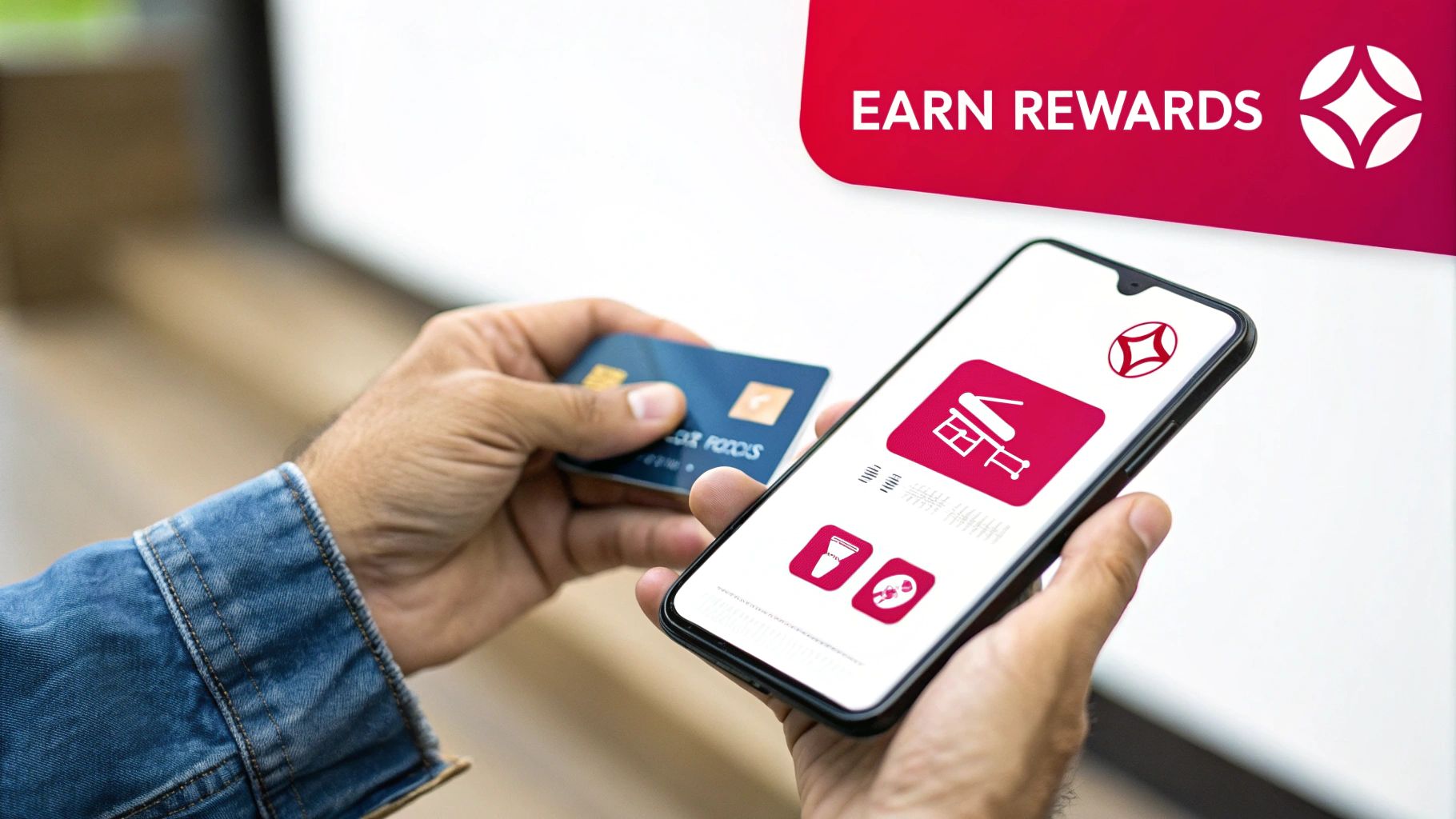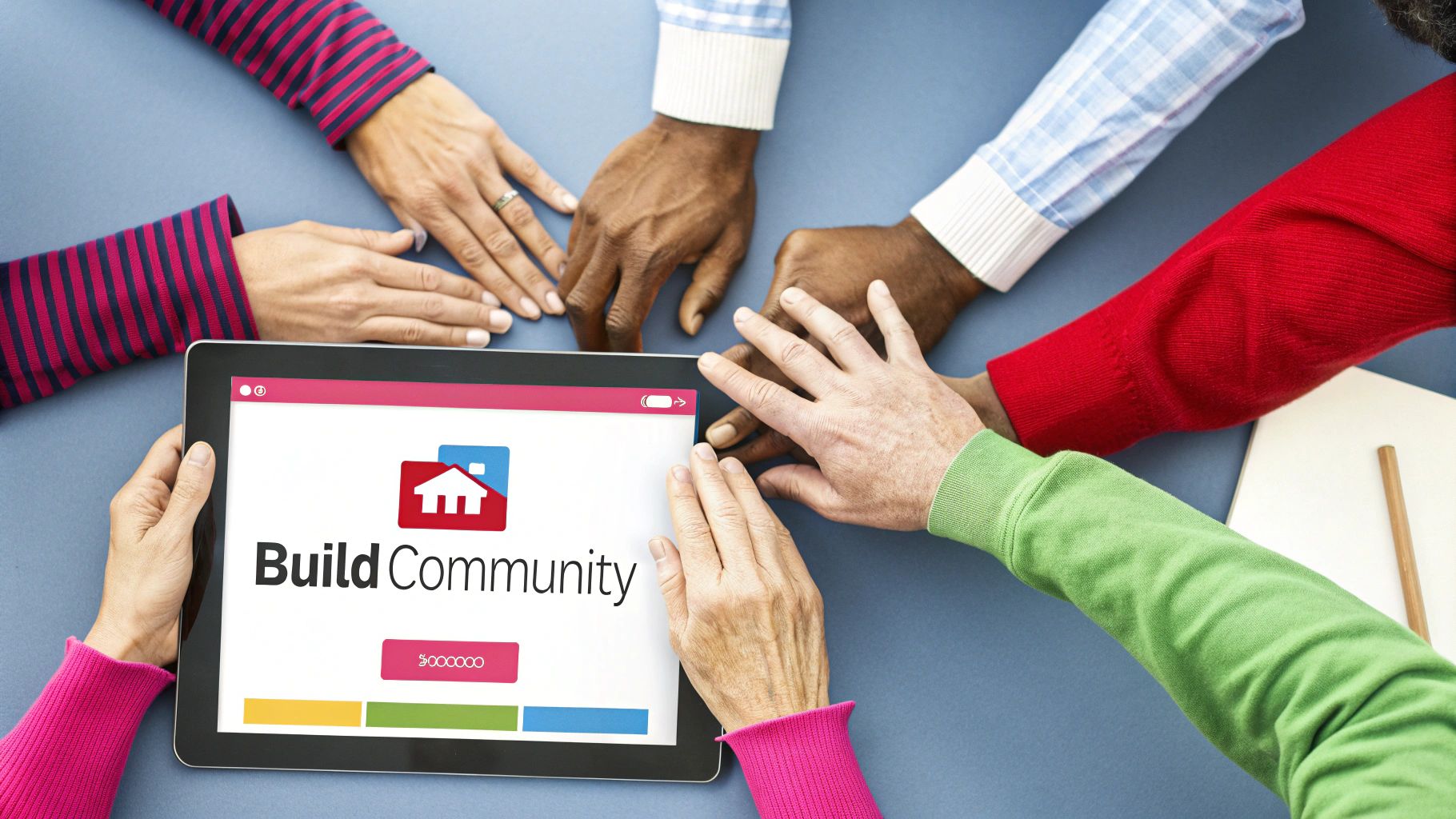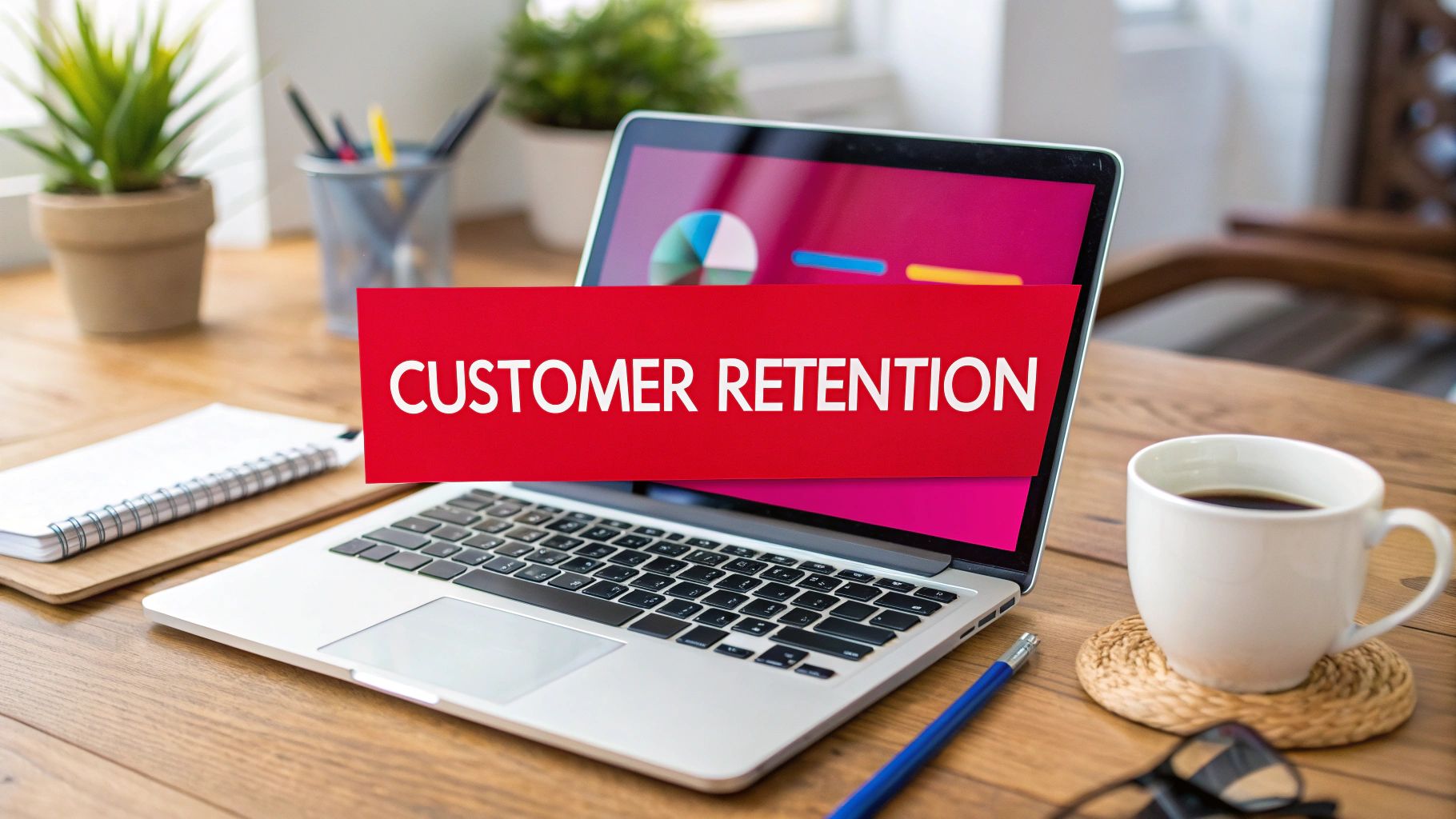In today's competitive market, attracting new customers is only half the battle. True, sustainable growth is built on the foundation of a loyal customer base. The reality is that acquiring a new customer can cost five times more than retaining an existing one, and increasing customer retention rates by just 5% can boost profits by 25% to 95%. This article moves beyond generic advice to provide a deep dive into proven customer retention strategies that deliver measurable results.
We will explore 10 powerful, actionable methods, from hyper-personalisation to proactive support, designed for businesses of all sizes, including startups, SMBs, and large enterprises. While foundational concepts are important, and you can explore these excellent four customer retention strategies for SaaS for a solid base, this guide focuses on a wider, more comprehensive set of tactics.
Whether you're aiming to reduce churn, increase customer lifetime value, or transform satisfied clients into passionate brand advocates, these strategies provide the blueprint you need. For businesses in the UAE and beyond, mastering customer retention is no longer optional; it is the critical engine for long-term success and profitability. We will break down each strategy with real-world examples, practical implementation tips, and key metrics to help you build a robust retention framework.
1. Personalized Customer Experience
Personalization is one of the most powerful customer retention strategies available today. It involves tailoring interactions, products, and services to individual customer needs using data analytics and insights. Instead of a one-size-fits-all approach, you create unique experiences based on purchase history, browsing behaviour, and stated preferences, making customers feel understood and valued.

This strategy moves beyond simply using a customer's first name in an email. It leverages deep data to anticipate needs and offer relevant solutions. For example, Amazon’s product recommendations and Netflix's content suggestions are prime examples of personalization driving engagement and loyalty. Similarly, Spotify’s "Discover Weekly" playlists keep users returning by offering a curated experience that feels uniquely their own.
How to Implement Personalization
- Start with Segmentation: Begin by grouping customers based on broad criteria like demographics or past purchase categories before moving to one-to-one personalization.
- Ensure Data Compliance: Be transparent about the data you collect and adhere strictly to privacy regulations like GDPR. Customer trust is paramount.
- Test and Measure: Use A/B testing to experiment with different personalization elements, such as product recommendations on a homepage versus in an email, to see what drives the best results.
- Balance Automation and Human Touch: While automation is key for scaling, ensure there are opportunities for human interaction, especially for high-value customers or complex support issues. To understand these critical touchpoints, you can gain valuable insights by developing a customer journey map on grassrootscreativeagency.com.
2. Loyalty Programs and Rewards
Loyalty programs are structured marketing initiatives designed to incentivise repeat business and foster long-term customer relationships. By offering tangible rewards, points, or exclusive benefits, these programs create a powerful reason for customers to choose your brand over competitors. This systematic approach not only recognises customer loyalty but also actively encourages future purchases, turning occasional buyers into devoted brand advocates.

This strategy is one of the most effective customer retention strategies because it provides clear, immediate value. For instance, the Starbucks Rewards program integrates mobile ordering with a tiered point system, while Sephora's Beauty Insider offers birthday gifts and early access to products. Similarly, Amazon Prime's combination of free shipping and exclusive content has created an ecosystem where loyalty is continuously rewarded. Central to retention is building strong customer loyalty; discover more about strategies to increase customer loyalty to deepen your approach.
How to Implement Loyalty Programs
- Make Rewards Attainable: Ensure that the rewards are valuable to your target audience and can be earned without unreasonable effort. If rewards feel out of reach, customers will quickly disengage.
- Keep It Simple: The program rules should be clear and easy to understand. A complicated system for earning or redeeming points can frustrate customers and defeat the program's purpose.
- Leverage Data for Personalisation: Use customer purchase history to offer personalised rewards and communications. Tailored offers show customers you understand their preferences and value their business.
- Create Emotional Connections: Go beyond transactional discounts. Offer emotional rewards like exclusive access, special recognition, or community-based perks that make customers feel like insiders.
- Use Technology for Convenience: Implement a seamless digital experience for tracking points and redeeming rewards. A user-friendly app or online portal is crucial for modern loyalty programs.
3. Proactive Customer Support
Proactive customer support is one of the most effective customer retention strategies because it solves problems before they escalate. This approach involves anticipating customer needs or issues and addressing them before the customer even reaches out. By monitoring behaviour, identifying potential friction points, and offering timely solutions, you transform the customer service experience from reactive to preventative, demonstrating that you are truly looking out for their best interests.

This strategy builds immense trust and loyalty. For instance, Amazon proactively notifies customers about potential shipping delays and provides updated delivery estimates without being asked. Similarly, HubSpot's customer success teams monitor "health scores" to identify at-risk accounts, reaching out with helpful resources to get them back on track. This foresight prevents customer churn by showing you value their success and are invested in their experience beyond the initial purchase.
How to Implement Proactive Support
- Use Data to Identify Risks: Analyse customer data to spot early warning signs, such as a drop in product usage or a history of support tickets. Implement a customer health scoring system to flag accounts that may need attention.
- Automate Proactive Communications: Set up automated alerts and workflows. For example, send an email with a tutorial video if a user has not engaged with a key feature after a certain period.
- Empower with Self-Service: Develop a comprehensive knowledge base, FAQ section, and community forums. This allows customers to find answers instantly, reducing frustration and support overheads.
- Train Your Team to Be Proactive: Coach support staff to not just solve the immediate issue but also to anticipate future questions or related problems, providing a more complete and satisfying resolution.
4. Customer Success Management
Customer Success Management (CSM) is a proactive business methodology focused on ensuring customers achieve their desired outcomes while using your products or services. It goes beyond reactive customer support by dedicating resources to help customers maximise value, which in turn fosters loyalty and reduces churn. This strategy is about partnering with your customers for their long-term success, making your solution indispensable to their operations.

Pioneered by SaaS companies like Salesforce, this approach treats customer retention as an active, ongoing process. For example, HubSpot uses customer health scoring to identify at-risk accounts, while Slack’s customer success teams focus on driving user adoption and feature expansion within organisations. These companies understand that a customer’s success is directly tied to their own, making CSM one of the most effective customer retention strategies for long-term growth.
How to Implement Customer Success Management
- Define Success Metrics: Work with customers to establish what success looks like for them. Create clear, measurable key performance indicators (KPIs) for different customer segments.
- Implement Health Scoring: Develop a customer health score based on factors like product usage, engagement levels, support tickets, and survey feedback to proactively identify issues.
- Structure Onboarding: Create a detailed and structured onboarding process that guides new customers to their first "win" or moment of value as quickly as possible.
- Conduct Regular Business Reviews: Schedule regular check-ins or quarterly business reviews (QBRs) with key accounts to discuss their progress, address challenges, and align on future goals.
- Align Team Incentives: Tie the compensation of your customer success team to retention and expansion metrics, such as net revenue retention (NRR), to ensure their goals are aligned with the company's.
5. Omnichannel Communication
Omnichannel communication is a crucial customer retention strategy that creates a seamless and integrated experience across every channel a customer uses to interact with your brand. It ensures that conversations and context are maintained whether a customer switches from web chat to a phone call or from a social media message to an in-store visit. This unified approach makes interactions effortless and consistent, reinforcing brand reliability and customer trust.
Unlike a multichannel approach where channels operate in silos, omnichannel connects them. For example, Starbucks allows customers to order and pay ahead via its mobile app, check their rewards balance online, and then pick up their order in-store without any friction. Similarly, Disney offers a flawlessly integrated experience where its website, mobile app (for ride times and bookings), and in-park services all work together to create a magical and stress-free customer journey. This consistency is a powerful driver of loyalty.
How to Implement Omnichannel Communication
- Invest in a Unified Platform: Use a Customer Data Platform (CDP) or CRM to centralise customer data and interactions from all channels into a single profile.
- Map the Customer Journey: Identify all potential touchpoints where customers interact with your brand to understand where handoffs between channels occur and how to make them smoother.
- Ensure a Consistent Brand Voice: Develop clear guidelines so that your brand's tone, messaging, and service quality are the same across email, social media, phone, and in-person interactions.
- Train Your Team: Equip your support and sales staff with the tools and training needed to access customer history and seamlessly manage cross-channel conversations.
6. Value-Added Services
Value-added services are a powerful customer retention strategy, involving extra benefits or features offered beyond your core product. These services enrich the customer experience by solving related problems, providing convenience, or creating new reasons for customers to stay engaged. By increasing the perceived value of your offering, you build a more robust, integrated relationship that is harder for competitors to replicate.
This strategy transforms a simple transaction into a comprehensive solution. A prime example is Amazon Prime, which bundles fast shipping with video streaming, music, and more, creating an ecosystem that customers are reluctant to leave. Similarly, HubSpot's free educational resources and marketing tools provide immense value beyond its core software, establishing it as an indispensable partner for business growth. These services make customers feel they are getting more than just a product; they are getting a complete package.
How to Implement Value-Added Services
- Identify Complementary Needs: Use customer feedback and data to discover services that align with their goals and complement your primary offering.
- Start Small and Test: Begin with low-cost, high-impact services to gauge customer response before investing heavily. This minimises risk and provides valuable insights.
- Support the Core Product: Ensure your added services enhance, rather than distract from, your main product. The goal is to strengthen the overall value proposition.
- Consider Strategic Partnerships: Collaborate with other companies to provide services outside your expertise, allowing you to expand your offerings efficiently.
- Measure the Impact: Track how these services influence key metrics like customer lifetime value, churn rate, and satisfaction to prove their effectiveness as a retention tool.
7. Regular Communication and Engagement
Maintaining regular communication is a fundamental customer retention strategy that keeps your brand top-of-mind and strengthens customer relationships. This involves a systematic approach to providing ongoing, valuable content through various touchpoints, moving beyond purely transactional interactions. By consistently educating, informing, and engaging, you build a community around your brand and demonstrate that you value customers for more than just their purchases.
This strategy is about creating a consistent dialogue. For example, HubSpot has mastered this with its extensive library of blog posts, webinars, and educational email series that empower its users. Similarly, Patagonia builds incredible loyalty through content focused on its environmental activism and community stories, creating a connection based on shared values. Nike also excels here, using its apps to launch fitness challenges and foster community engagement, keeping users connected to the brand long after a sale.
How to Implement Regular Communication
- Develop a Content Calendar: Plan your communications in advance with a consistent publishing schedule. This ensures a steady flow of valuable content without overwhelming your audience.
- Segment Your Audience: Tailor your messaging to different customer groups based on their interests, behaviour, or lifecycle stage. This makes your communication far more relevant and effective.
- Focus on Value, Not Just Sales: Prioritise content that educates, entertains, or solves a problem. A good rule of thumb is the 80/20 rule: 80% value-driven content and 20% promotional.
- Use Multiple Channels: Reach customers on their preferred platforms, whether it's email newsletters, social media updates, blog posts, or community forums.
- Encourage Two-Way Dialogue: Ask for feedback, run polls, and respond to comments promptly. Making customers feel heard is crucial for building a strong relationship and improving your customer retention strategies.
8. Customer Feedback and Improvement
One of the most direct customer retention strategies is to actively listen to your audience and act on their insights. This involves systematically collecting, analysing, and implementing customer feedback to continuously enhance your products, services, and overall experience. When customers see their suggestions lead to tangible improvements, they feel heard and invested in your brand's success.
This strategy turns your customer base into a valuable source of innovation. For example, Slack famously uses a public roadmap and integrates user feedback directly into its development cycle. Similarly, Tesla's over-the-air software updates often include features and fixes requested by its owner community, creating a dynamic product that evolves with customer needs. This proactive approach builds a powerful, loyal following.
How to Implement a Feedback Loop
- Offer Multiple Channels: Make giving feedback effortless. Use a mix of surveys, social media listening, in-app prompts, and a dedicated feedback portal to capture diverse perspectives.
- Acknowledge and Respond: Respond to all feedback promptly, even if it's just to acknowledge receipt. This shows you are listening and value the customer's time and effort.
- Close the Loop: This is the most critical step. When you implement a change based on feedback, notify the customers who suggested it. This demonstrates impact and strengthens their connection to your brand.
- Analyse for Trends: Don't just react to individual comments. Analyse feedback data to identify recurring themes and systemic issues that need strategic attention. This is also a key component of effective online reputation management on grassrootscreativeagency.com.
9. Community Building
Creating a brand community is a powerful customer retention strategy that transforms individual customer relationships into a collective, supportive network. It involves fostering a space where customers can connect with each other and the brand, united by shared interests and values. This sense of belonging deepens emotional loyalty, turning customers into passionate advocates who actively engage with and promote your brand.
This approach creates a self-sustaining ecosystem of support and engagement. Think of Peloton's vibrant community, where leaderboards and group challenges foster friendly competition and shared motivation. Similarly, Sephora's Beauty Insider Community provides a platform for enthusiasts to share tips and reviews, while the Salesforce Trailblazer Community offers invaluable peer-to-peer support for its users. These communities provide immense value beyond the core product, making the brand indispensable.
How to Implement Community Building
- Define Your Community's Purpose: Identify the common interests, goals, or values that unite your customers. A community built around a shared purpose is more likely to thrive.
- Choose the Right Platform: Select a platform that suits your audience, whether it's a dedicated forum on your website, a Facebook Group, a Slack channel, or a specialised community platform.
- Facilitate Connections and Content: Actively moderate discussions, post valuable content, and create opportunities for members to interact with each other, such as through virtual events or Q&A sessions.
- Recognise and Empower Members: Acknowledge and reward active contributors to encourage participation. Feature user-generated content and create exclusive benefits or leadership roles for your most dedicated members.
10. Surprise and Delight Initiatives
Surprise and delight initiatives are one of the most emotionally resonant customer retention strategies, focusing on creating unexpected positive experiences that forge a deep connection with your brand. This approach moves beyond transactional relationships by offering spontaneous gestures that exceed customer expectations, turning ordinary interactions into memorable moments. These initiatives generate powerful positive sentiment and organic word-of-mouth marketing.
This strategy is epitomised by brands like Chewy, which sends handwritten holiday cards and even sympathy flowers when a customer’s pet passes away. Similarly, Zappos became legendary for its surprise overnight shipping upgrades, creating a legion of loyal fans. These gestures show customers they are seen as individuals, not just order numbers, fostering a level of loyalty that competitors find difficult to break.
How to Implement Surprise and Delight Initiatives
- Empower Frontline Staff: Give your customer service teams the autonomy and a small budget to create surprise moments. A free coffee, a small discount, or an upgraded service can have a massive impact when delivered at the right time.
- Focus on Emotional Impact: The most effective initiatives are not necessarily the most expensive. A thoughtful, personalised note or a gesture tied to a customer's personal milestone often carries more weight than a generic monetary discount.
- Use Data for Personalisation: Leverage your customer data to identify key moments like birthdays, anniversaries, or significant purchase milestones. Acknowledging these events with a small, unexpected gift makes the experience feel personal and genuine.
- Amplify Through Social Media: Encourage customers to share their surprise moments online. This not only validates the initiative but also generates powerful user-generated content. You can learn how to leverage these stories through effective social media marketing for startups at grassrootscreativeagency.com.
Customer Retention Strategies Comparison
| Strategy | Implementation Complexity 🔄 | Resource Requirements ⚡ | Expected Outcomes 📊 | Ideal Use Cases 💡 | Key Advantages ⭐ |
|---|---|---|---|---|---|
| Personalized Customer Experience | High: advanced data infrastructure & analytics | High: data platforms, skilled analysts | Increased satisfaction, loyalty, conversion, lifetime value | Businesses with rich data and diverse customer base | Highly tailored experiences, competitive edge |
| Loyalty Programs and Rewards | Medium-High: program design & tech integration | Medium-High: program management, tech | Increased repeat purchases, engagement, higher spending | Retail, subscription, brands incentivizing repeat behavior | Encourages loyalty, gathers valuable customer data |
| Proactive Customer Support | High: requires predictive tech & monitoring | Medium-High: monitoring tools, staffing | Reduced churn, customer satisfaction, lower support volume | Service companies aiming to preempt issues | Prevents frustration, builds trust |
| Customer Success Management | High: dedicated teams and processes | High: trained CSMs, ongoing engagement | Reduces churn, drives adoption and expansion | B2B SaaS, complex products needing customer enablement | Strong relationships, expanded revenue |
| Omnichannel Communication | High: complex integration of multiple channels | High: unified systems, staff training | Seamless experience, higher engagement, brand consistency | Brands with multi-touchpoint customer journeys | Consistency across channels, convenience |
| Value-Added Services | Medium-High: additional offerings & expertise | Medium-High: new services, partnerships | Increased stickiness, revenue streams, satisfaction | Companies expanding core offerings | Differentiation, premium pricing opportunities |
| Regular Communication & Engagement | Medium: content creation & scheduling | Medium: marketing resources | Maintains awareness, builds engagement and loyalty | Brands focusing on content marketing & community | Builds emotional connection, upsell opportunities |
| Customer Feedback & Improvement | Medium: feedback systems & analysis | Medium: tools for collection & response | Improves products, satisfaction, innovation | Companies seeking continuous improvement | Customer-driven innovation, loyalty |
| Community Building | High: managing platforms and engagement | High: community managers, content | Strong brand connection, peer support, user content | Brands fostering user collaboration & advocacy | Emotional connection, network effects |
| Surprise and Delight Initiatives | Medium-High: creativity & execution | Medium: personalized rewards and staffing | Emotional connection, brand differentiation | Brands seeking emotional loyalty and advocacy | Memorable experiences, positive word-of-mouth |
Integrating Your Retention Efforts for Maximum Impact
Navigating the landscape of customer retention can feel overwhelming, especially with the array of powerful strategies we have explored. From crafting deeply personalised experiences and proactive support systems to building vibrant communities and leveraging omnichannel communication, the path to fostering loyalty is multifaceted. However, the most crucial takeaway is that these tactics should not exist in silos. True mastery of customer retention strategies lies in their integration, creating a seamless and cohesive ecosystem that places the customer at its very centre.
Imagine how these elements amplify one another: a robust loyalty programme becomes exponentially more valuable when its rewards are personalised based on individual customer data. Proactive support is made more insightful when it is informed by a continuous stream of customer feedback. A surprise and delight initiative feels more genuine and impactful when delivered within an engaged brand community you have carefully nurtured. The real magic happens when your efforts harmonise, creating a unified front that consistently communicates value and appreciation to your customer base.
From Theory to Action: Your Next Steps
The journey to building a resilient, loyal customer base is a marathon, not a sprint. It is a continuous cycle of learning, adapting, and refining your approach. To move from insight to implementation, consider these actionable steps:
- Conduct a Customer Journey Audit: Start by mapping out your current customer journey from initial awareness to post-purchase engagement. Identify the key touchpoints and pinpoint the areas where friction occurs or where the experience feels impersonal. This audit will reveal the most significant opportunities for improvement.
- Prioritise and Implement: You do not need to launch all ten strategies at once. Select one or two initiatives that align most closely with your immediate business goals and your customers' expressed needs. Whether it is launching a simple tiered loyalty programme or establishing a formal customer feedback loop, focus on executing it exceptionally well before expanding.
- Measure, Analyse, and Iterate: Define clear Key Performance Indicators (KPIs) for your chosen strategies. This could include metrics like Customer Lifetime Value (CLV), churn rate, or Net Promoter Score (NPS). Regularly analyse the data to understand what is working and what is not, and use these insights to make informed adjustments to your approach.
Ultimately, investing in sophisticated and well-integrated customer retention strategies is not just about reducing churn; it is about building a sustainable, profitable, and resilient business. When you consistently deliver exceptional value and show your customers they are more than just a transaction, you transform them into your most powerful asset: lifelong brand advocates. This commitment to your existing customers will create a powerful ripple effect, driving organic growth and solidifying your brand's reputation in a competitive marketplace.
Ready to transform your customer journey into a powerful engine for growth? The team at Grassroots Creative Agency specialises in developing and executing data-driven customer retention strategies tailored to the unique needs of businesses in the UAE and beyond. Let us help you build the loyalty programmes, engagement campaigns, and personalised experiences that turn satisfied customers into passionate advocates.








